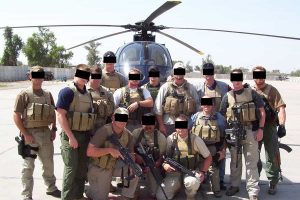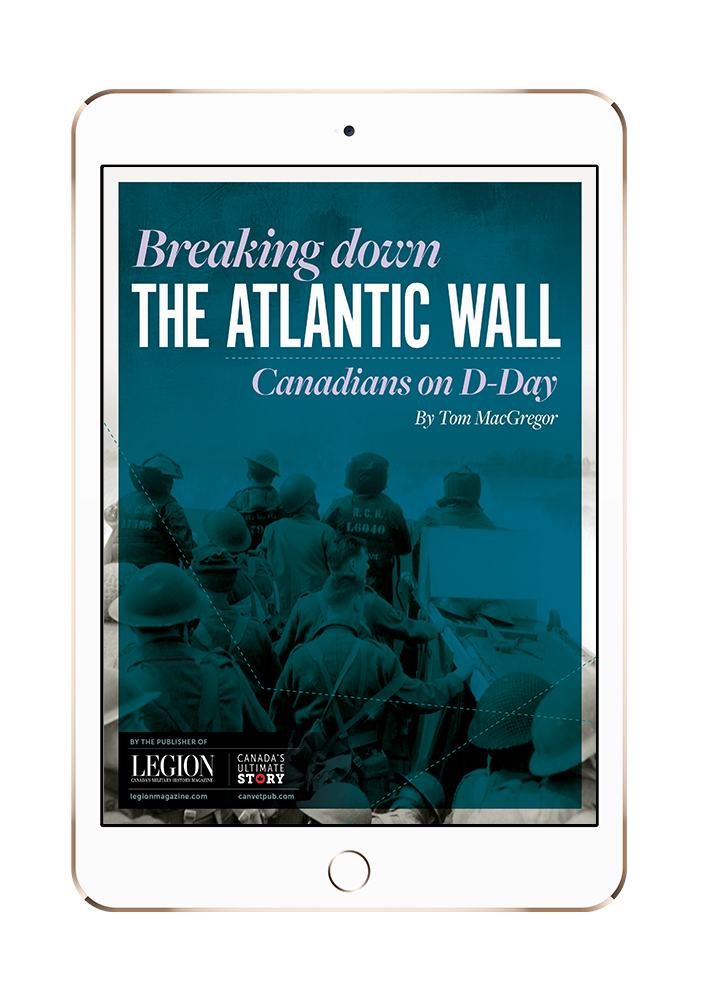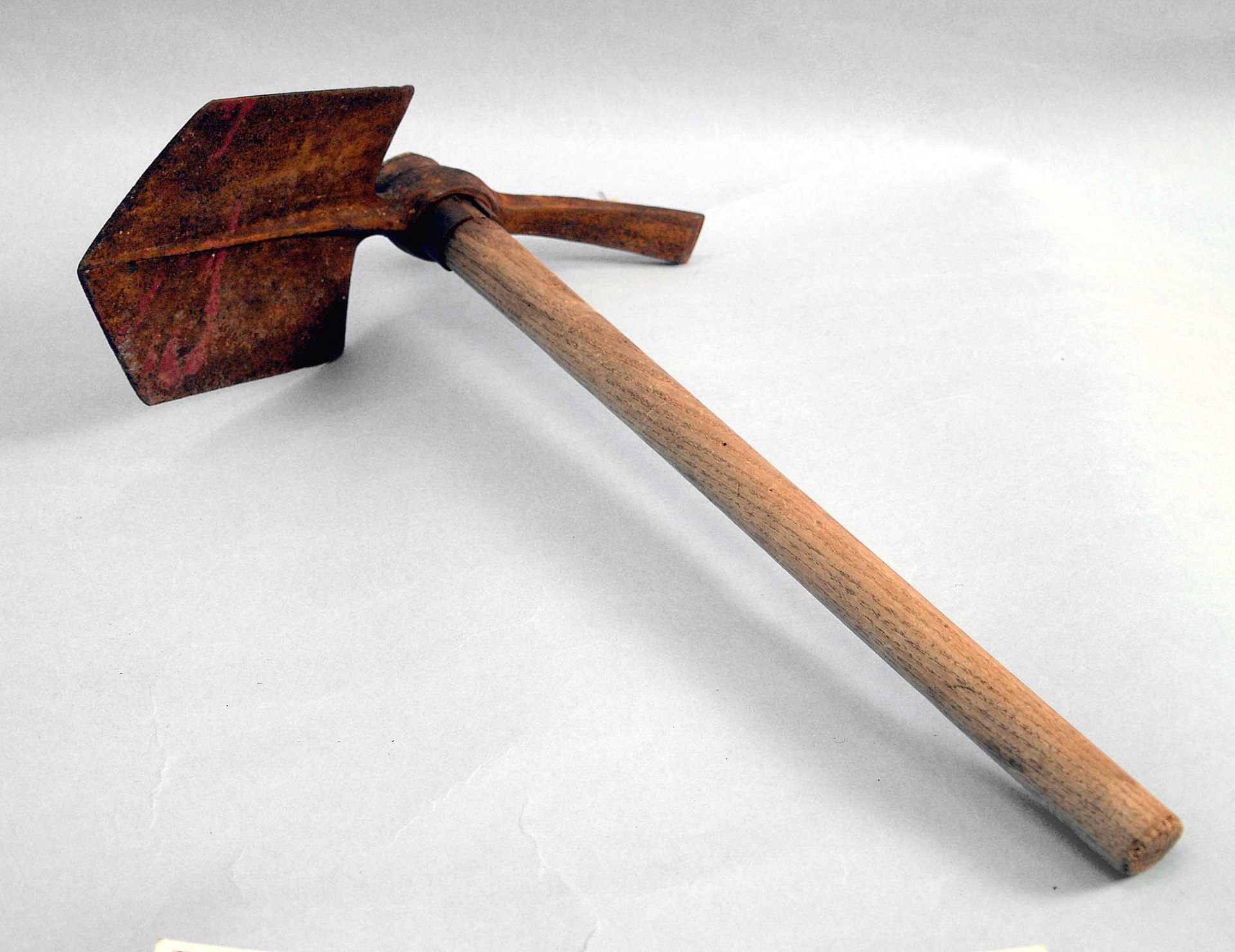
Entrenching tools like this WW I-era model have long been used for much more than digging. Beginning in 1915, soldiers routinely sharpened the shovel for use as a weapon in close-quarters fighting.
[Auckland Museum]
Yes, the lowly shovel, known in military parlance as the entrenching, or intrenching, tool, also called a trenching tool, or simply e-tool—any way you call it, the shovel, or spade, has provided shelter, convenience, security and, to the degree possible, peace of mind to millennia of grunts. So long as you had your shovel, you had options.
With the right combination of arms, shoulders, legs and back at the top end, the business end of the shovel dug life-sustaining wells, trenches and foxholes; filled sandbags and potholes; removed obstacles and erected barriers. It fashioned cooking pits and latrines; chopped wood and pried objects; removed earth, debris and rubble from trapped soldiers and civilians. And it buried the dead.
“Although military technology has advanced in considerable ways in the last century or so, the simplest, stealthiest, and most effective form of digging is still a soldier carrying a shovel,” Jessica Stevenson wrote for the Royal Canadian Regiment Museum.
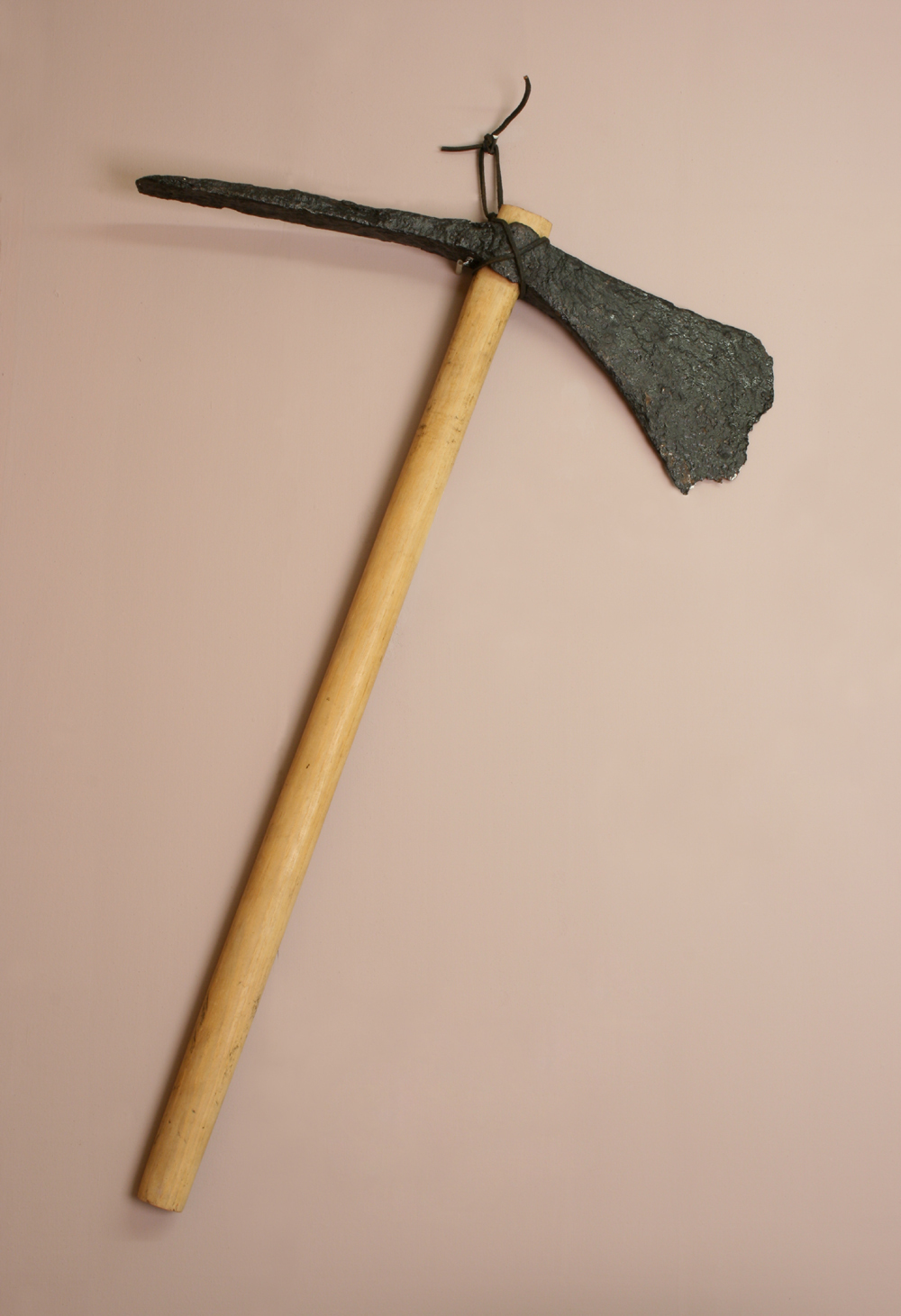
Early Roman legionaries used the dolabra to break up ground when ditch digging or clearing scrub. It may also have been used for fighting.
[Future Museum]
In a controversial Facebook post written in January 2018, U.S. Command Sergeant Major John Wayne Troxell, the senior enlisted advisor to the chairman of the Joint Chiefs of Staff, wrote that the Islamic State group had two options: “surrender or die.”
“If they surrender, we will safeguard them to their detainee facility cell, provide them chow, a cot and due process,” Troxell declared. “HOWEVER, if they choose not to surrender, then we will kill them with extreme prejudice, whether that be through security force assistance, by dropping bombs on them, shooting them in the face, or beating them to death with our entrenching tools.”
Troxell retired from a 37-year military career in 2019 and, after a last address to the graduating class of his Texas alma mater, the Sergeants Major Course at the NCO Leadership Center of Excellence in Fort Bliss, he was presented with an entrenching tool bearing the engraving “surrender or die by any means necessary.”
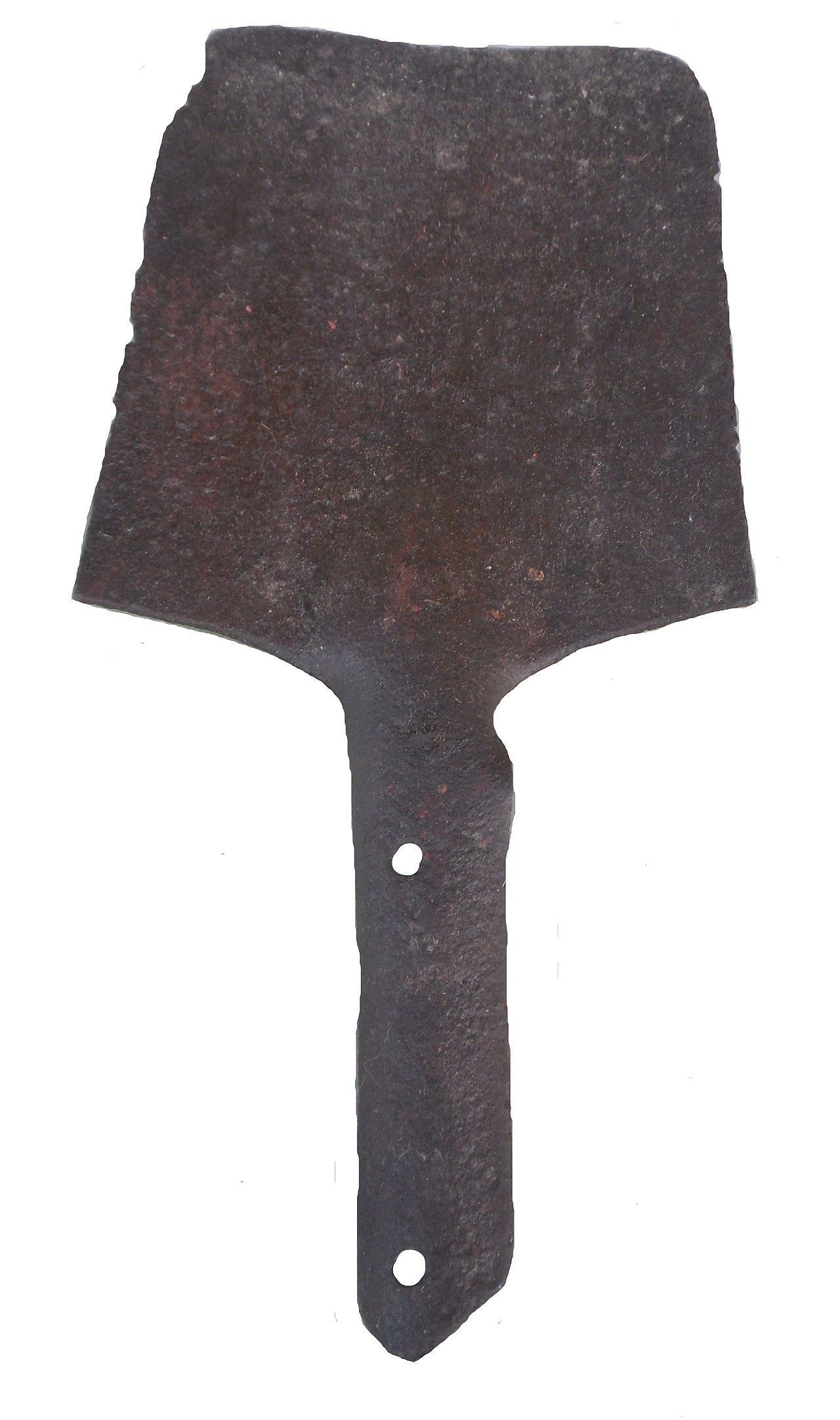
A Linnemann shovel from Romania. Only Russia recognized the patent of its creator, a Danish officer named Mads Johan Buch Linnemann.
[Wikimedia]
Entrenching tools date at least to the Roman legion, which used a type of mattock (a long-handled pickaxe-type tool used for digging, prying and chopping). They called it a dolabra. There is documented evidence that Julius Caesar and other ancients considered spades and other digging implements important tools of war.
After long days on the march, Roman legionaries would dig ditches and ramparts fortified with mobile stakes around their encampments.
Later, siege tactics started with the shovel. During the Napoleonic Wars, soldiers used long, heavy spades and pickaxes to dig trenches toward the walls of besieged fortifications. Once close enough, they brought in the cannons.
This digging equipment was typically carried by supply cart. Only pioneer or engineer troops regularly carried spades or shovels as part of their individual equipment.
Often, this meant there was no entrenching equipment at hand when the general infantry needed it. “The intrenching tools of an army rarely get up to the front until the exigency for their use has passed” became an infantry truism.

U.S. Model 1873 trowel bayonet and scabbard was recently auctioned off by Bonhams for 587.50 US.
[Bonhams Skinner]
The much bigger Austrian army took it on in 1871, and the enterprising Linnemann opened a factory in Vienna to meet the demand. It was later adopted by Germany, France, Romania and Russia, though only Russia recognized Linnemann’s patent rights. It paid him 30,000 rubles and ordered 60,000 spades.
The Russians called it the MPL-50 (small infantry spade, 50 centimetres long) and still use it today. It can dig, all right, but it can also be used as an axe, a hammer, an oar, or as a frying pan for cooking food. And a weapon.
The year 1870 proved something of a boon for multi-task digging implements. The U.S. army came up with the trowel bayonet in 1870, which besides digging and killing, could be used to plaster log huts and stone chimneys for winter quarters. One edge was sharpened to cut tent poles, pins and, well, flesh. Ten thousand were issued before it was deemed obsolete in 1881.
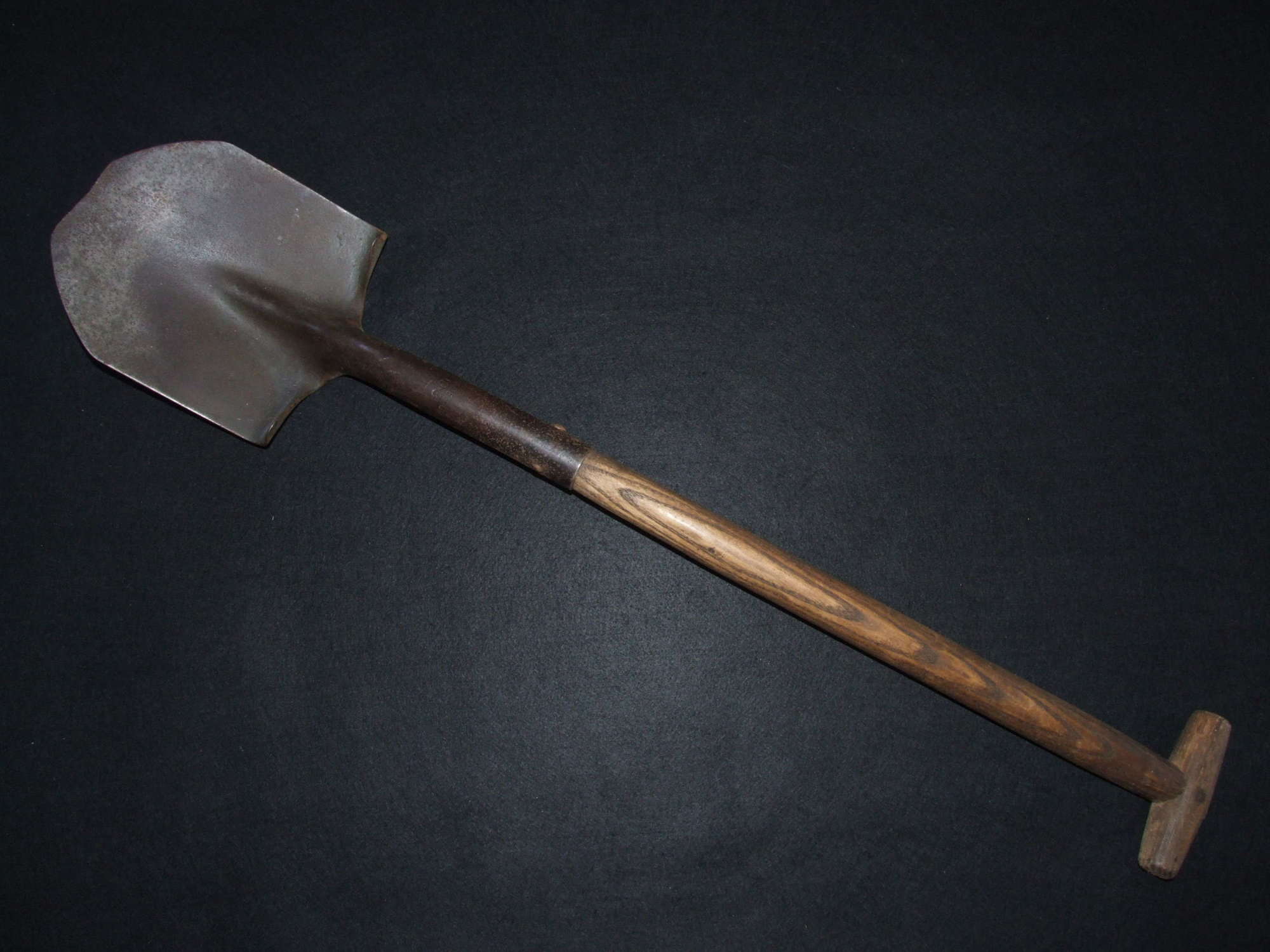
The well-used “Shovel, General Service,” or GS shovel, tend to vary in height depending on the level of wear at the end of the spade.
[The Militaria Zone]
The British entrenching tool of the day was a two-parter, with a wooden handle and a metal head consisting of an adze or spade blade and a pickaxe spike. The pick spike could serve as a handle for digging.
There was a ring between the blade and the spike into which the wooden handle could be inserted at right angles to the head so the tool could be used as a pick mattock to chop away at dirt or the sides of a trench.
The tool was carried in two pieces in a canvas pouch attached to the lower back of a soldier’s webbing. The metal head rested inside the pouch while the helve (handle) was threaded through two outer loops.
“This E-tool was unpopular with soldiers as they found it difficult to assemble the pieces quickly when needed,” writes Stevenson. “Additionally, the small spade-size and limited digging styles afforded by the mattock-style use made it difficult to dig either large formations or for extended periods of time.”
Their unpopularity notwithstanding, this 1908 pattern tool was used throughout WW I into the 1930s, though British and Canadian troops were issued stronger tools for larger projects, including the “Shovel, General Service,” or GS shovel.
Produced by both British and Canadian manufacturers, it consisted of a larger spade attached to a long wooden handle for digging heavier fortifications. The relics tend to vary in height depending on the level of wear at the end of the spade.
It was during WW I that the entrenching spade also came into its own as a so-called melee weapon. Rifles and fixed bayonets were often too long and unwieldy for the confines of a trench. Entrenching tools more than sufficed for close-quarters combat.
In her 1945 novel, The Pursuit of Love, Nancy Mitford wrote that there hung over the chimney piece an entrenching tool “with which, in 1915, Uncle Matthew had whacked to death eight Germans one by one as they crawled out of a dug-out. It is still covered with blood and hairs, an object of fascination to us as children.”
Not only can you get a man under the chin, but more to the point, you can strike a blow with a lot more force behind it.
From 1915, soldiers of all stripes routinely sharpened the edges of entrenching shovels for use as weapons. They have been described as latter-day battle-axes.
“The bayonet isn’t as important as it used to be,” wrote Erich Maria Remarque, a German WW I veteran who drew on his own experiences to author All Quiet on the Western Front. “It’s more usual now to go into the attack with hand-grenades and your entrenching tool.
“The sharpened spade is a lighter and more versatile weapon…not only can you get a man under the chin, but more to the point, you can strike a blow with a lot more force behind it. That’s especially true if you can bring it down diagonally between the neck and the shoulder, because then you can split down as far as the chest. When you put a bayonet in, it can stick, and you have to give the other man a hefty kick in the guts to get it out.”
The German Klappspaten foldable spade first appeared in 1938. It was the precursor of all modern entrenching tools, including the 1943 American copy.
Folding designs became increasingly popular—usually a fixed handle with a folding shovel head, sometimes incorporating a pick into the design. Like all individual entrenching tools, they were crafted to be easily carried as part of an infantry soldier’s standard kit. But the convenience came at a cost: a folded tool took time to unfold, rendering it virtually useless when at close quarters and time was of the essence.

The WW II-era German Klappspaten folding spade would set the trend for all future designs.
[Wikimedia]
During the Second World War, German and Soviet forces used entrenchment tools in close-quarters combat, notably in the brutal hand-to-hand fighting during the Battle of Stalingrad.
“I bought once a Swedish army entrenching tool,” former tank gunner Johann Weber, presumably German, wrote in an online discussion about their use as weapons. “My grandfather saw it and sharped it to shaven sharp. It was very good for hacking down tree root balls.
“I was so young that I didn’t understand why he wanted so keenly to sharpen it. Only later I understood why… he had served during WW2 in Eastern Front. Old habits never die.”
His medal citation says he then “led a bayonet attack, which…killed approximately 27 hostile soldiers.”
In 1951, First Lieutenant Benjamin F. Wilson of the U.S. army earned a Medal of Honor after resorting to his entrenching tool during a third and final assault by Chinese troops during the Korean War.
After his unit came upon a much larger enemy force in Hwach’on-Myon, Korea, Wilson dashed into enemy fire to assist members of his unit who were pinned down. He killed four enemy fighters with his rifle and grenades.
His medal citation says he then “led a bayonet attack, which…killed approximately 27 hostile soldiers.” The enemy launched a counterattack.
“First Lieutenant Wilson, realizing the imminent threat of being overrun, made a determined lone-man charge, killing seven and wounding two of the enemy, and routing the remainder in disorder.”
A third assault ensued. By the time it was over, all Wilson had in his hands was his entrenching tool.
“Unhesitatingly, First Lieutenant Wilson charged the enemy ranks and fought valiantly, killing three enemy soldiers with his rifle before it was wrested from his hands, and annihilating four others with his entrenching tool,” reads his citation.
“His courageous delaying action enabled his comrades to reorganize and effect an orderly withdrawal. While directing evacuation of the wounded, he suffered a second wound, but elected to remain on the position until assured that all of the men had reached safety.”
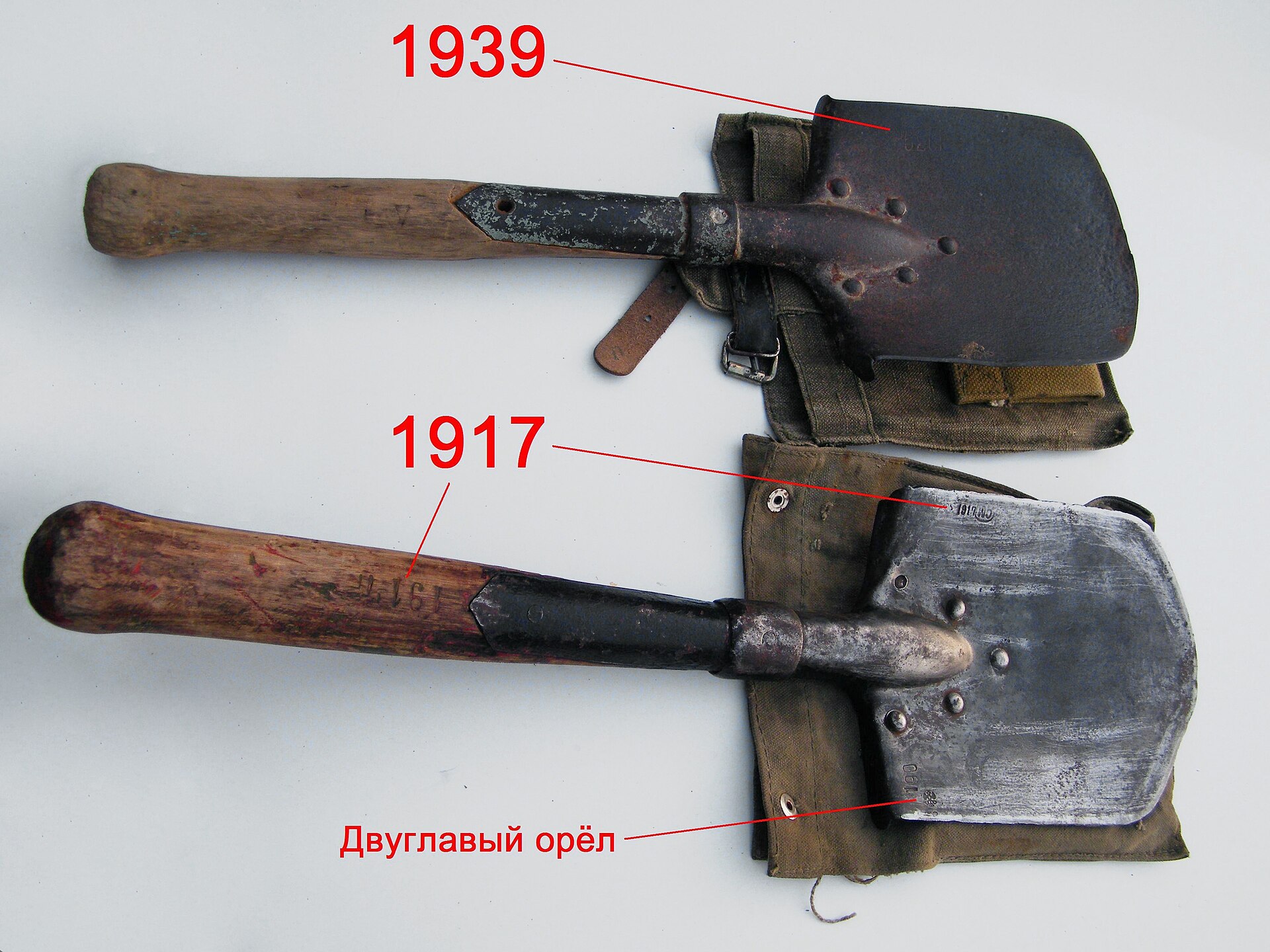
The World War I- and II-era Russian MPL-50 (malaya pekhotnaya Lopata, or small infantry spade) didn’t change much and was similar to the entrenching tools used by most armies of their respective eras.
[Wikimedia]
U.S. army Private First Class Anthony T. Kaho‘ohanohano was out of ammunition, wounded, and determined to provide cover for retreating friendly forces in Chup’a-ri, South Korea, in 1951 when his unit was overrun by a superior enemy force.
Leading a machine-gun squad supporting Company ‘H,’ 2nd Battalion, 17th Infantry Regiment, 7th Infantry Division, Kaho‘ohanohano “fought fiercely and courageously, delivering deadly accurate fire into the ranks of the onrushing enemy,” according to his Medal of Honor citation.
“When his ammunition was depleted, he engaged the enemy in hand-to-hand combat until he was killed. His heroic stand so inspired his comrades that they launched a counterattack that completely repulsed the enemy. Coming upon Private Kaho‘ohanohano’s position, the friendly troops found 11 enemy soldiers lying dead before it and two in the emplacement itself, beaten to death with an entrenching shovel.”
“Private First Class Grover, armed only with the entrenching tool, unhesitatingly attacked the Viet Cong.”
In 1969, U.S. Marine Corps Private First Class Lewis Grover was without a conventional weapon in Quang Nam province, Vietnam, when he spotted a lone Viet Cong fighter in a bunker.
Grover, a rifleman with Company ‘H,’ 2nd Battalion, 5th Marines, was refilling his unit’s canteens when he spotted the enemy. Grover pretended not to notice the fighter, then quietly picked up an entrenching tool he found on the riverbank.
“He then maneuvered to a position from which he could approach the bunker entrance unseen,” said his Silver Star citation. “When an enemy soldier carrying an automatic weapon came out of the bunker, Private First Class Grover, armed only with the entrenching tool, unhesitatingly attacked the Viet Cong.”
The U.S. army entrenching tool has evolved from the Pattern 1907, non-folding, T-handled spade to a tri-fold design with a modified D-handle design and all-steel construction, to a similar lightweight plastic and steel trifold adopted by NATO as its standard-issue entrenching tool.
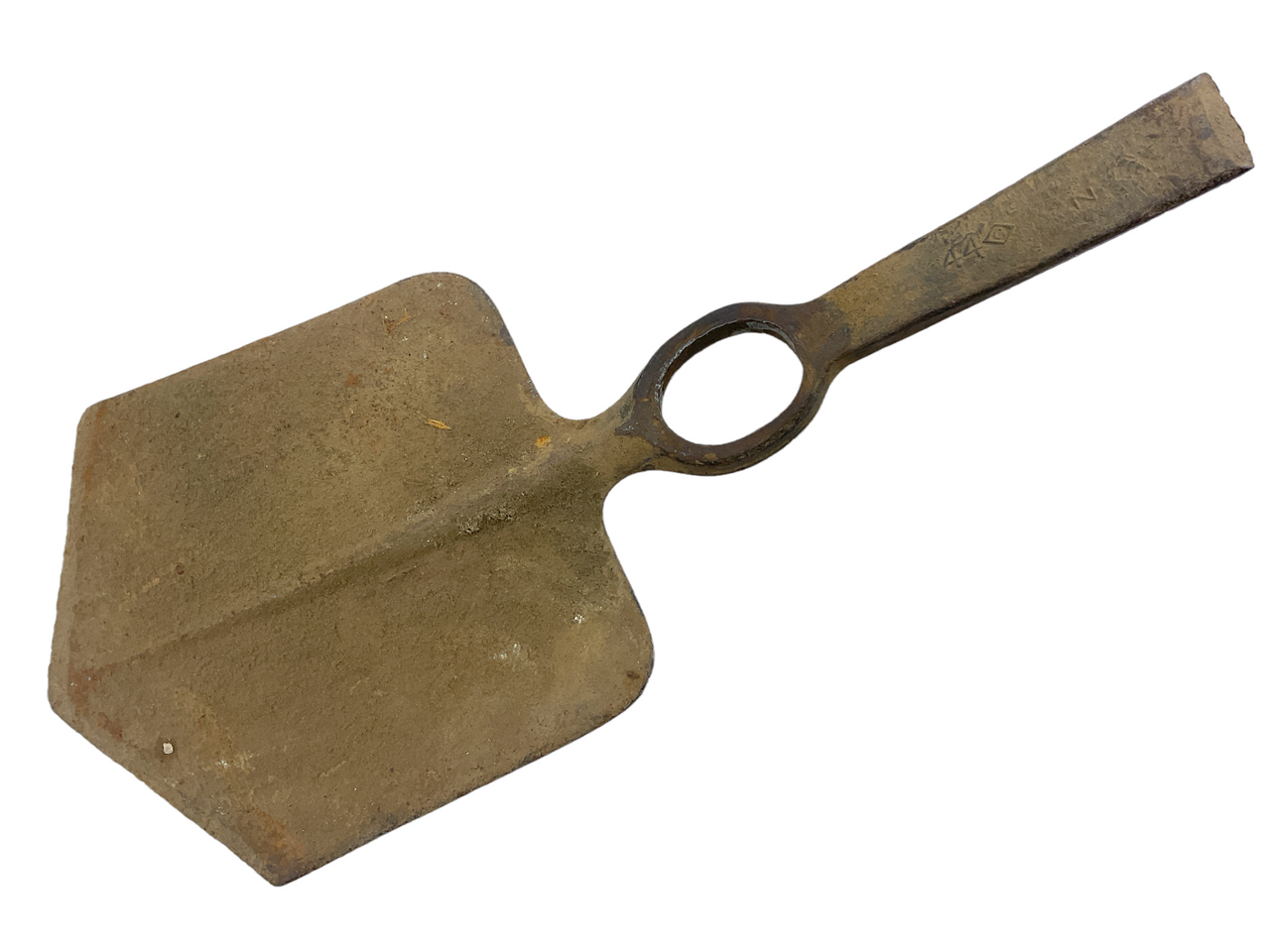
A WW II Canadian-British 1944-dated e-tool head with the middle ring for the optional wooden handle. [ebay]
Germany’s Glock Feldspaten (field spade) features a hardened metal spade blade lockable in three positions for digging, shoveling and chopping. It also features a telescopic, fiberglass-reinforced nylon handle containing a 175mm-long hardened metal saw blade. It weighs 650 grams and, fully extended, is 630mm long. The spade and handle can be collapsed and shortened for easy transport and storage.
Soviet Spetsnaz (special forces) units were well trained in the use of the standard short-handled Russian entrenching shovel (saperka) as a weapon; by the nature of their missions, such tools were only rarely used for digging or entrenching positions.
Modern commando forces, including the U.S. Green Berets, are trained to fight with entrenchment tools.
From spiked clubs to Molotov cocktails to razor-sharpened entrenching tools, soldiers always find ways to make something out of nothing when more conventional and sophisticated means of attack and defence are unavailable.
Advertisement








